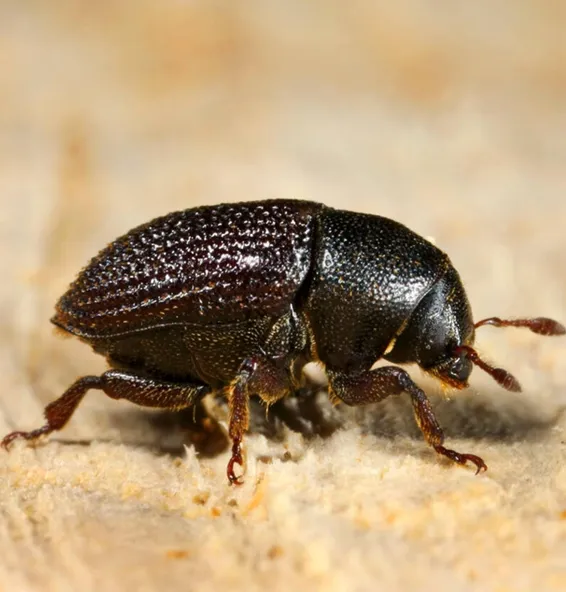Mediterranean pine bark beetle, known as Orthotomicus erosus, is a species that primarily damages all types of pine trees in Turkey, especially the red pine. It is also known to affect cedar trees.
Mediterranean pine bark beetle can cause damage from April to October, depending on weather conditions. This pest leads to the drying out and death of trees. Since it causes significant damage to trees, combating this beetle is of great importance. Pheromone traps are frequently used in the fight against this species.
Pine Bark Beetle
This beetle species, common in the Mediterranean, Aegean, and Marmara regions, inflicts its most severe damage on pine trees. Known as a secondary pest, it feeds on and reproduces in forest trees, causing significant destruction during this process.
With a cylindrical body shape, the beetle is dark brown or black in color. It penetrates under the bark of trees, forming galleries and disrupting the trees’ nutrient pathways. Damaged trees dry out and die.
Female beetles lay around 60-80 eggs and produce 2-3 generations per year. The larvae feed on the woody tissue of trees and develop over a few weeks into adults. It is a dangerous beetle with a high reproductive capacity.
This species causes great losses in forest ecosystems, making control efforts essential.
The damages caused by the bark beetle include:
- Significant destruction of pine trees, leading to symptoms like wilting, leaf shedding, and tree death.
- Blocking the tree’s ability to absorb water and nutrients.
- In cases of intense attacks, forest fires may occur as the dried branches can ignite easily.
The bark beetles primarily target weak or stressed trees, causing severe damage.
This pest is particularly destructive to Mediterranean tree species, but it is also known to affect other types of pine trees.
Environmental factors such as climate change and drought can make it difficult to control the beetle population, making it essential to employ effective control methods.

What is the Relationship Between the Mediterranean Pine Bark Beetle and Other Insects?
Hard-shelled flying insects share some similarities with this species. Both types belong to the group of hard-shelled beetles. Thanks to these hard shells, they can easily live under tree bark in forests. Both species also have the ability to fly, allowing them to spread over a wide area in forests.
Another type is known as cocoon-making insects. These insects create cocoons at the end of their larval stage for protection. The cocoon-making stage is part of their life cycle. However, the Mediterranean beetle does not need a cocoon to survive; it lives under the bark of trees.
The common feature of both types is their hard shell, which allows them to endure harsh conditions and continue living under tree bark.
Although these insect species share some characteristics with the pine bark beetle, they differ in their biological traits and life cycles.
Combating the Mediterranean Pine Bark Beetle
The question, “How can the Mediterranean pine bark beetle be eradicated?” is frequently asked. Pheromone traps are often used to combat this pest. These traps mimic the pheromones released by female beetles, luring male beetles into the trap where they are exterminated. This method helps to monitor and control the population, reducing its numbers.
The advantages of pheromone traps include:
- They are species-specific, meaning they target only one type of insect, preventing harm to beneficial organisms.
- They are important for population control and monitoring.
- They reduce the use of chemicals, thus protecting human health and the environment.
- They are easy to install and low-cost.
In addition to pheromone traps, other control methods include:

Cultural Control: This involves regular inspection of forests, pruning or cutting down infected trees to prevent the spread of the beetle.
Biological Control: This method uses natural enemies such as insect-eating birds and parasites to control the beetle population.
Chemical Control: Although insecticides are used in this method, they pose significant risks to the ecosystem, so they are not preferred.
For more information on controlling the Mediterranean pine bark beetle, you can contact Kapar Organik.
